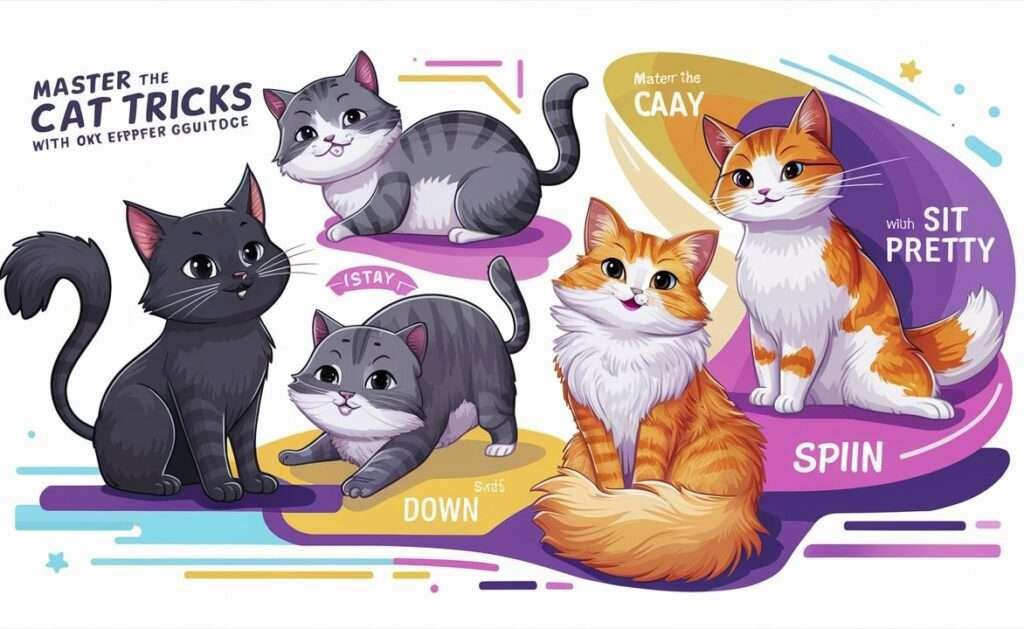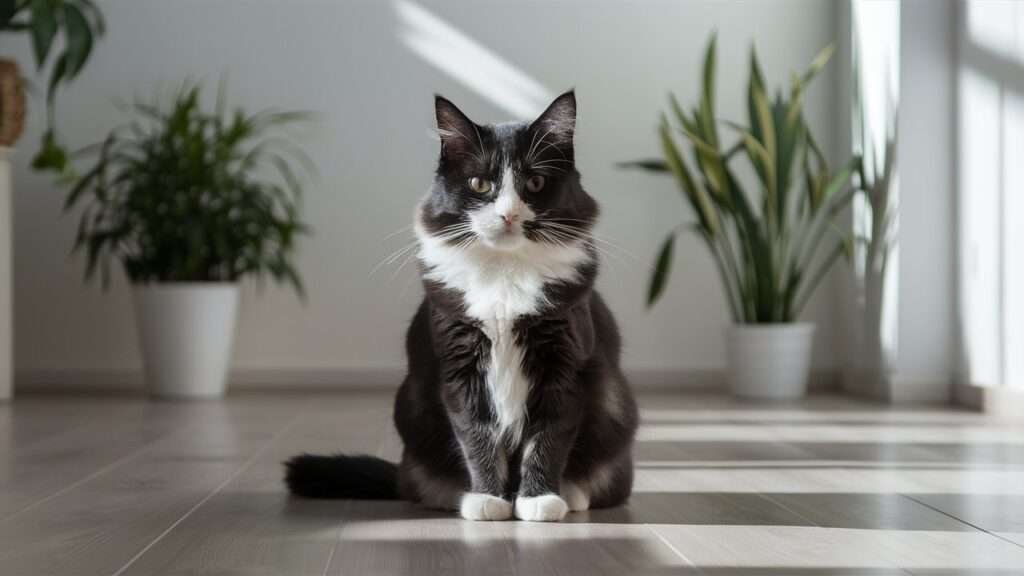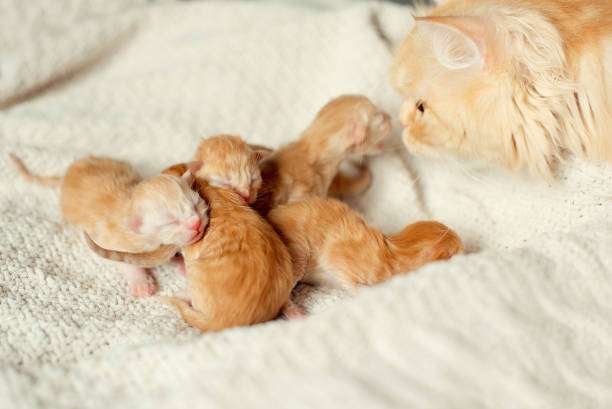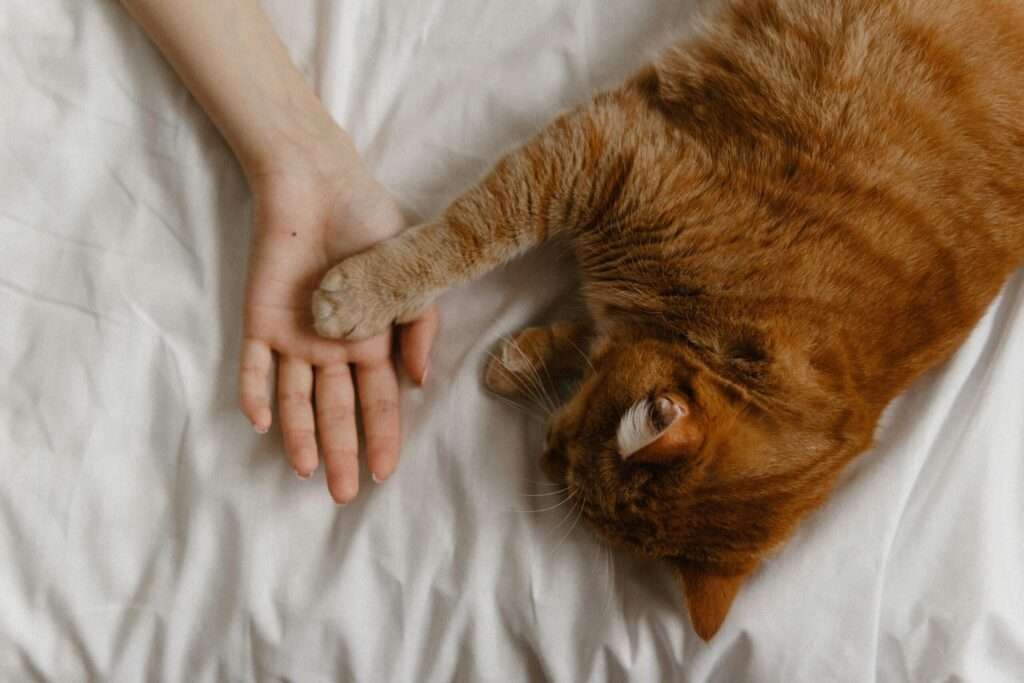Teaching your cat tricks not only transforms them into the star of the show when guests visit, but also enhances the bond and communication between you and your cat in ways you never imagined. Clicker training simplifies our cat training by marking the exact moment our cat performs the desired behavior. Not all tricks are the same, so before diving into the impressive tricks you see on TikTok or Instagram, I highly recommend starting with those that will significantly improve your cat’s life. Before teaching any fun tricks, it’s essential to train your cat to come on call and finger target. I’ll include links to those tutorials in the description box below for you to read after this article. If your cat already knows these basics, fantastic! If not, don’t worry; every trick in this article is straightforward, and you can teach them from scratch.
In today’s article, I want to share five tricks that are both useful and cool, as well as easy to teach: sit down, sit pretty, stay, and spin. Whether you’re a cat mom, a cat dad, or someone who’s had a cat for a while and is looking for new ideas, consider subscribing. I’ll be uploading new tips and tricks weekly to help you engage more with your cat. Now that the introduction is done, let’s get into it.
Table of Contents
ToggleWhat is a clicker training?
Cat clicker training is extremely straightforward, and you can teach your cat nearly anything using classic conditioning, clicker training, or the mark and reward method. Clicker training focuses on encouraging the behaviors you want to see more frequently in your cat. Cats tend to repeat behaviors that result in rewards, like treats, so you may wonder how the clicker fits into this process. The clicker, or marker, signals to your cat the precise moment they perform the desired behavior. Clicker training is quite easy; with this approach, you can teach your cat virtually anything. There are three steps to clicker train your cat. Step one: avoid feeding your cat beforehand. Step two: charge the clicker. Step three: begin marking the behaviors you want to reinforce in your cat. That’s all there is to it.
Don’t provide your cat with unlimited food access as it will make them less motivated to perform the desired behaviors since treats are their reward. Charging the clicker is the most critical step. If your cat doesn’t associate the clicker’s sound with receiving food, they won’t understand that you are reinforcing a behavior. Avoid making the sound if you don’t plan to reward your cat. Ensure that each time the clicker sounds, your cat recognizes something positive has happened.
It will take some time for your cat to link the sound with a reward, so practice this consistently for three or four times a day in five-minute sessions over a week. Consistency is crucial. The sound from the clicker is distinctive, making it easier for your cat to associate this specific sound with the behavior you want to reinforce. You can use any sound-producing device as long as it makes a unique sound, ensuring your cat doesn’t expect a treat randomly. Produce the sound exactly when your cat performs the desired behavior.
5 Common Mistakes in Cat Training and How to Avoid Them
Not Properly Charging the Clicker
Mistake: The clicker is not properly charged.
Solution: Charging the clicker is nothing more than priming your cat with the knowledge that after a click comes a reward. Start training sessions by charging the clicker. Grab six or seven treats, get comfortable, and start clicking and rewarding for no reason at all.
Feeding Treats Incorrectly
Mistake: Feeding them treats with the same hand that is doing the command or feeding them with the correct hand but directly to their mouth instead of dropping them on the floor.
Solution: Throw the treats away from your hand to tell your cat that the treats are coming far away from your hand and allow your cat to unwind between exercises.
Free Feeding
Mistake: Allowing your cat to eat whenever they want.
Solution: Put your cat on a schedule. Feed your cat three to four times a day, with meals spaced six to eight hours apart. Use automatic feeders if you’re not at home. Strategically place training sessions between meals to increase food motivation.
Using the Wrong Treats
Mistake: Using treats that do not motivate your cat.
Solution: Find treats that your cat goes crazy for. For example, use freeze-dried chicken for complex tricks or outdoor training. Break supermarket treats into smaller pieces to avoid overfeeding.
Training When Cat is Not in the Mood
Mistake: Trying to train a distracted or uninterested cat.
Solution: Stop the training and play with your cat instead. Trigger their curiosity with fast moves and let the prey sit and wait for your cat to pounce on it. Alternate play with throwing treats after a click to keep them engaged in the training session.
These tips will help you avoid common mistakes and improve your training sessions with your cat.
Top 7 Cat tricks
Sit
Sit is a simple yet super useful trick you want to teach your cat. I use it with my cat all the time when I want to keep her still to put the harness on and off or when I don’t want her roaming around when we’re outdoors. We’re going to have the treat in our right hand and the clicker in the left hand. If you’re a lefty, you can do it the other way around. We’re going to hold the treat between our thumb and our middle finger with our index finger pointing up. We’re going to hover the treat over our cat’s head. At some point, our cat is going to sit to try to reach the treat with their mouth. As soon as their butt touches the floor, click, then reward. You have to repeat this process 5 to 10 times.
Once our cat understands the behavior, we can remove the treat from our right hand but we’re going to keep doing the same gesture. If our cat doesn’t react without the treat, this means that they still haven’t understood the movement. Do it five to ten times more and try again without the treat. Once your cat reacts quickly to the gesture without the treat, it’s time to add the verbal command “sit.” Good girl! After several days using both the physical command as well as the verbal command, our cat is going to understand the verbal command on its own, and we can try to get them to do it without the physical command.
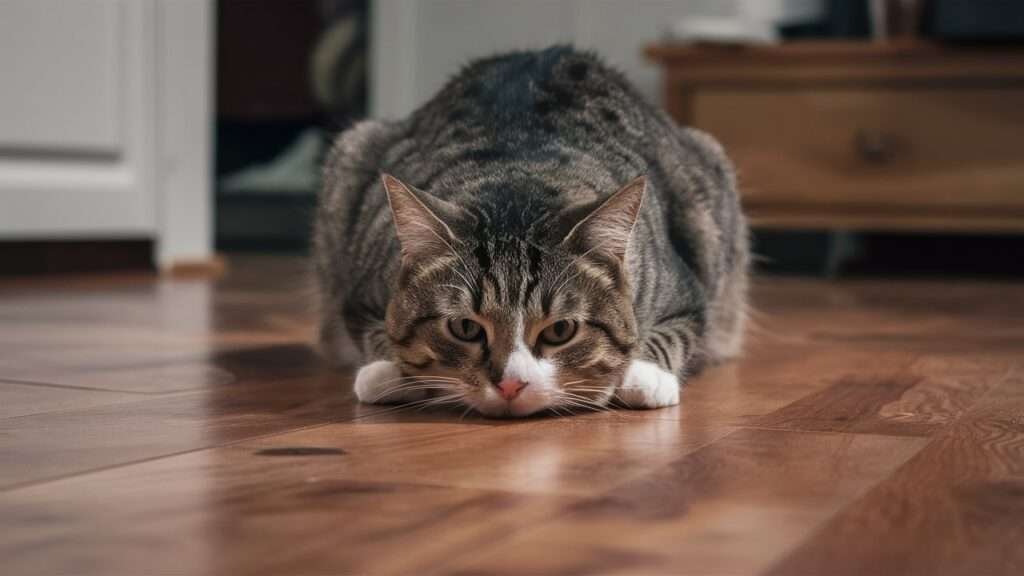
Down
Down isn’t a useful trick by itself, but it’s the very first step towards other tricks like roll over or play dead. Before teaching the down command, our cat has to master sit. Sit, down, good girl! From the sitting position, you’re going to get a treat and hide it under your fingers. When your cat tries to reach it, they’re going to touch with their belly on the floor. At that time, you click, then reward.
At some point, your cat is going to react almost instantly to the gesture. When that happens, it means that your cat has mastered the trick. Then it’s the right moment to remove the treat from underneath your fingers. Sit, down. Again, if our cat struggles without the treat, just add again the treat. There’s no problem with that.
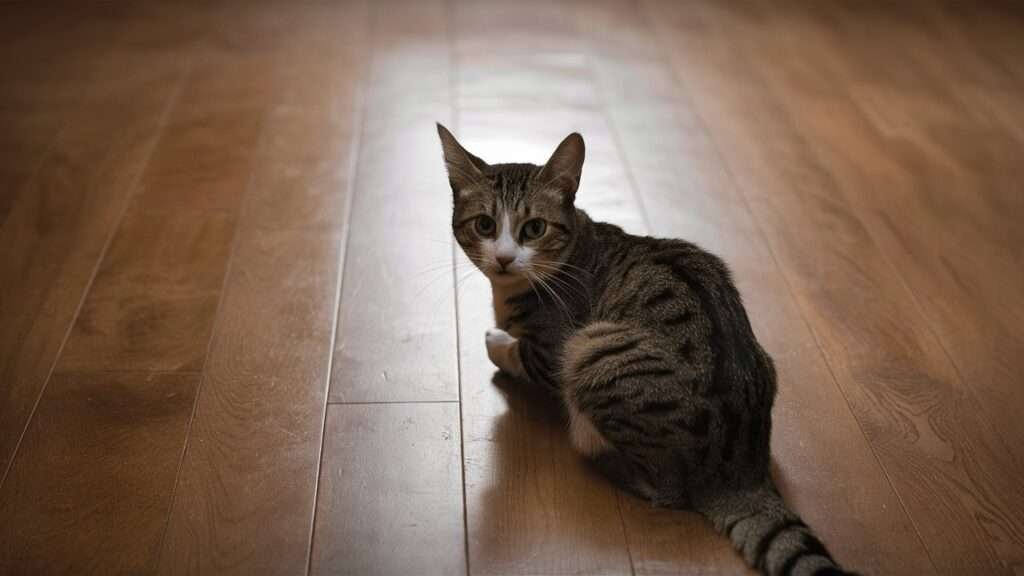
Stay
The stay command is a game changer for every cat owner. It will help you serve food without being disturbed, stay, no, stay, good girl, or take amazing pictures of your cat while it’s on a rock, and you need a couple of seconds to frame that shot. Your cat needs to know the stay command. We’re going to do the stay command and reward them for apparently no reason because the objective of this trick actually is rewarding them for doing nothing. Stay, good girl! We’re going to do the stay command again, and we’re going to walk a step back. Stay, good girl! If, while walking that step back, our cat doesn’t move, we click, then reward. In the case that our cat moves, we’re going to place them back in the spot and do it again.
The objective is to keep doing stay and walking farther and farther every time, increasing our standards until we decide to reward them.

Sit Pretty
Sit pretty is the very first cute trick I want you to teach your cat. Before teaching this trick, your cat needs to know how to sit first. From the sitting position, we’re going to take one treat and place it between our ring finger and our middle finger. With this setting, we’re going to hover it over their head out of reach. I highly recommend you trim your cat’s nails when teaching this trick. Two things can happen now: that your cat tries to reach the treat with their paws, no, or that your cat stands up, lifting both front legs, trying to reach the treat with their head. Good girl! As soon as the front legs lift off the floor, click, then reward. Once your cat has internalized the behavior and knows that this means up, you can remove the treat from between your fingers and do the gesture on its own. If your cat doesn’t understand the gesture on its own, place the treat back again. There’s no problem with that, and keep practicing with the treat between your fingers.
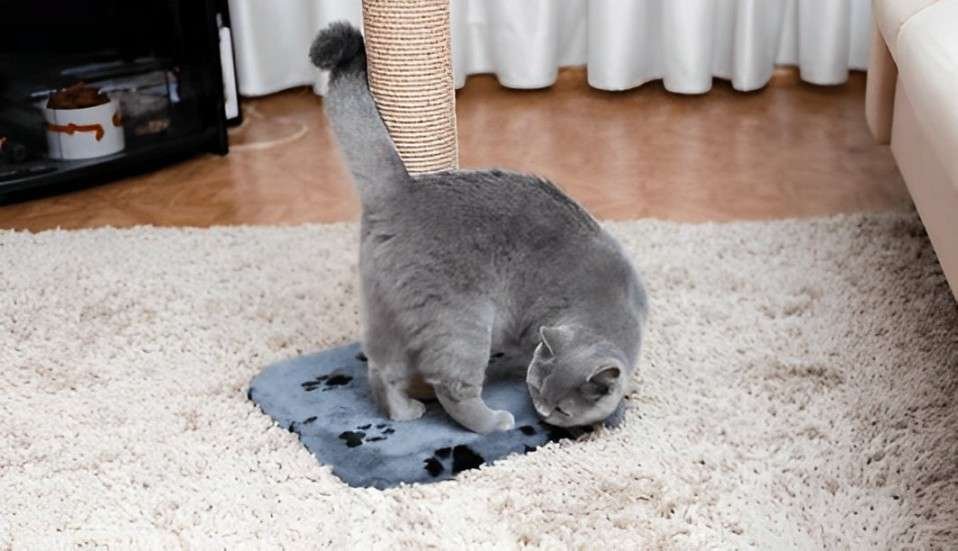
Spin
Okay, let’s teach spin now, the most useless trick of them all. To teach the spin, we’re going to lure our cat using a treat. Spin, good girl! We’re going to start with the treat in our right hand and doing the full circle with our right hand. Once our cat masters the full circle with our right hand, we’re going to place the treat in the other hand, and we’re going to do a half circle without anything, and we’re going to lure them over at the end of the spin with the treat in the other hand. Good girl! We might have to start luring them farther up at the beginning, but you will see that very early on they’re going to start following the right hand even if there’s no treat. Once the behavior is established, you can keep on doing the circle with your right hand and clicking as soon as your cat is facing towards you. Little by little, you’re going to want to have this big circle becoming smaller and smaller until it can become just a gesture.
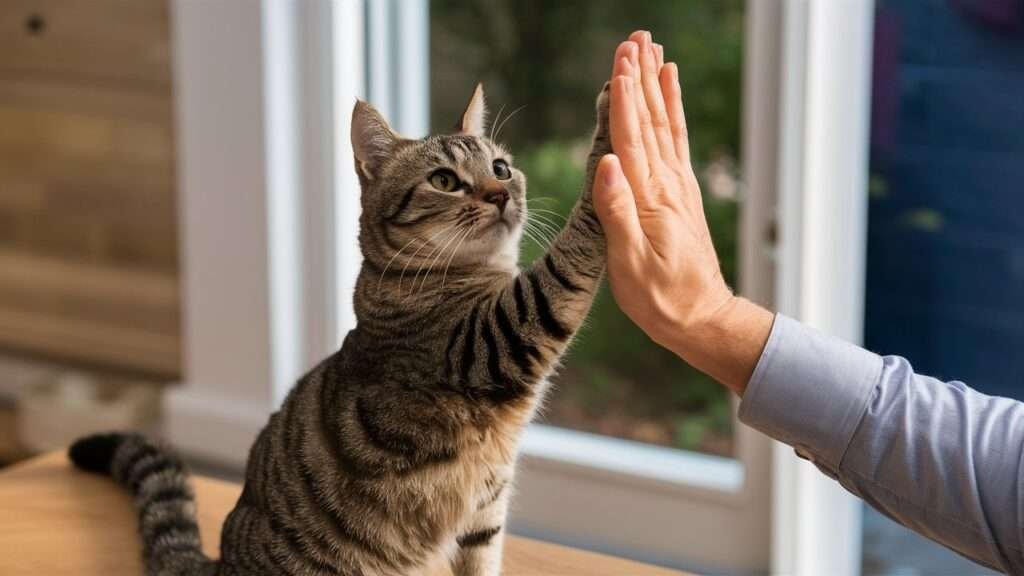
Highfive
For this trick, you’ll need a cup and treats. Put the treat in the cup so the only way your cat will get the treat is by using its paw. Following this step, whenever your cat puts its paw in the cup, say the phrase you want your cat to react to or just say “high five.” Make sure to keep repeating this step. When your cat is comfortable with the cup, start using your hand and don’t give your cat the treat if they don’t touch your hand. Don’t forget to say your phrase and make sure to say “good job” afterwards. Here’s a tip: make your hand into a cup shape and relax it when your cat can have the treat. Eventually, start putting your hand into the position you usually high five in. When you say your phrase, your cat should instantly know what to do. Keep doing this and I’m sure your cat will get it.

No
Teaching your cat to understand “no” can be done with positive reinforcement, rewarding them for stopping unwanted behavior instead of punishing them. “No” should simply tell your cat that their current behavior won’t be rewarded, not that they are bad.
To start, hold a treat in your open hand. If your cat tries to take it, close your hand and say “no.” Repeat this until your cat learns to wait for the treat. Next, put food on a table. If your cat tries to get it, cover the food with your hand and say “no.” Reward your cat when they stop trying and look at you.
For context training, place food where you don’t want your cat to go. Use a leash and harness to walk your cat. When they try to reach the food, say “no” and gently pull them away. Reward them when they stop. Begin this training in a quiet place with few distractions to ensure your cat can focus on learning. By following these steps, your cat will understand “no” and improve their behavior through positive reinforcement.
Today’s article has been a little different from others I’ve written before, but trust me, despite some of these tricks might seem useless, it’s really going to improve the communication between you and your cat as well as your bond. If you found this article interesting, informative, enriching in any way, please give it a thumbs up. It really helps me reach more people by telling them that this article might be worth reading. I’m super excited about the article that I’m working on for next week. Thank you for reading this so far

